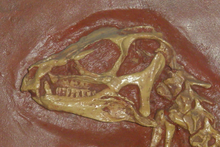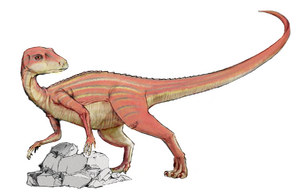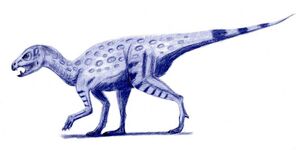| iHeterodontosaurids | ||||||||||||||||
|---|---|---|---|---|---|---|---|---|---|---|---|---|---|---|---|---|
 | ||||||||||||||||
| Scientific classification | ||||||||||||||||
| ||||||||||||||||
|
Heterodontosauridae ("different-toothed lizards") is a family of early ornithischian dinosaurs that have often been considered basal ornithopods, although recent studies suggest they may have been more closely related to marginocephalians. Although their fossils are rare, they lived around the globe beginning in the Late Triassic Period and may have persisted into the Cretaceous.
Heterodontosaurids were small dinosaurs, less than 3 meters (10 feet) in length. They are known mainly for their characteristic teeth, including enlarged canine-like tusks and cheek teeth adapted for chewing, analogous to those of Cretaceous hadrosaurs. Their diet was herbivorous or possibly omnivorous.
Anatomy
Among heterodontosaurids, only Heterodontosaurus itself is known from a complete skeleton. Fragmentary skeletal remains of Abrictosaurus are known but have not been fully described, while all other heterodontosaurids are known only from jaw fragments and teeth. Consequently, most heterodontosaurid synapomorphies (defining features) have been described from the teeth.[1][2]
In both Abrictosaurus and Heterodontosaurus, the eyes were very large, and underneath the eyes, the jugal bone projected sideways. This projection, called a boss, is also seen in ceratopsians. As in the jaws of most ornithischians, the anterior edge of the premaxilla was toothless and probably supported a keratinous beak (rhamphotheca), although heterodontosaurids did have teeth in the posterior section of the premaxilla. A large gap, called a diastema, separated these premaxillary teeth from the those of the maxilla. The mandible (lower jaw) was tipped by the predentary, a bone unique to ornithischians. This bone also supported a beak similar to the one found on the premaxilla. All mandibular teeth were found on the dentary bone.[1]

Cast of a Heterodontosaurus skull.
Heterodontosaurids are named for their strongly heterodont dentition. There were three premaxillary teeth. In the Early Jurassic Abrictosaurus, Heterodontosaurus, and Lycorhinus, the first two premaxillary teeth were small and conical, while the much larger third resembled the canine teeth of carnivoran mammals and is often called the caniniform or tusk. A lower caniniform, larger than the upper, took the first position in the dentary and was accommodated by the diastema of the upper jaw when the mouth was closed.[1] These caniniforms were serrated on both the anterior and posterior edges in Heterodontosaurus and Lycorhinus, while those of Abrictosaurus bore serrations only on the anterior edge.[3][4] In the Early Cretaceous Echinodon, the upper caniniform was apparently the first tooth of the maxilla, and there may have been two lower caniniforms on each dentary.[5][6]
Like the characteristic tusks, the cheek teeth of derived heterodontosaurids are also unique among early ornithischians. On the edges of these teeth were small ridges, or denticles, which lined the third of the tooth crown closest to the tip in all heterodontosaurids; in other ornithischians, the denticles extend further down towards the root. Basal forms like Abrictosaurus had cheek teeth in both maxilla and dentary that were generally similar to other ornithischians: widely-spaced, each having a low crown and a strongly-developed cingulum, a ridge which separated the crown of the tooth from the root. In more derived forms like Lycorhinus and Heterodontosaurus, the teeth were chisel-shaped, with much higher crowns and no cingula, so that there was no difference in width between the crowns and the roots. These derived cheek teeth were also overlapping, so that their crowns formed a continuous surface on which food could be chewed. The tooth rows were inset from the side of the mouth, leaving a space outside the teeth which may have been bounded by a muscular cheek, which would have been necessary for chewing.[1] The much later hadrosaurs and ceratopsians of the Cretaceous Period, as well as many herbivorous mammals, would convergently evolve somewhat analogous dental batteries. As opposed to hadrosaurs, which could have thousands of teeth constantly being replaced, tooth replacement in heterodontosaurids occurred far more slowly and several specimens have been found without a single replacement teeth in waiting. Heterodontosaurids boasted a unique spheroidal joint between the dentaries and the predentary, allowing the lower jaws to rotate outwards as the mouth was closed, grinding the cheek teeth against each other. Because of the slow replacement rate, this grinding produced extreme tooth wear that commonly obliterated most of the denticles in older teeth, although the increased height of the crowns gave each tooth a long life.[7]
The postcranial anatomy of Heterodontosaurus tucki has been well-described, although H. tucki is generally considered the most derived of the Early Jurassic heterodontosaurids, so it is impossible to know how many of its features were shared with other species.[1] The forelimbs were long for a dinosaur, over 70% of the length of the hindlimbs. The well-developed deltopectoral crest of the humerus and prominent olecranon process of the ulna indicate that the forelimb was powerful as well. There were five digits on the manus ('hand'). The first was large and tipped with a sharply curved claw. When flexed, this first digit would rotate inwards; it has been called the 'twist-thumb'.[8] The second digit was the longest, slightly longer than the third, and both also bore claws. The clawless fourth and fifth digits were very small and simple in comparison. In the hindlimb, the tibia was 30% longer than the femur, which is generally considered an adaptation for speed. The tibia and fibula of the lower leg were fused to the astragalus and calcaneum of the ankle, forming a tibiofibiotarsus convergently with modern birds. Also similarly to birds, the lower tarsal (ankle) bones and metatarsals were fused to form a tarsometatarsus. There are four digits in the pes (hindfoot), with only the second, third, and fourth contacting the ground. The tail, unlike many other ornithischians, did not have ossified tendons to maintain a rigid posture and was probably flexible.[9] The fragmentary skeleton known for Abrictosaurus has never been fully described, although the forelimb and manus are much smaller. The fourth and fifth digit of the forelimb each bear one fewer phalanx bone than those of Heterodontosaurus.[10]
Lifestyle

Abrictosaurus

Heterodontosaurus, based on the skeleton in display at the UCMP, Berkeley, CA
Most heterodontosaurid fossils are found in geologic formations that represent arid to semi-arid environments, including the Lower Elliot Formation of South Africa and the Purbeck Beds of southern England.[2] It has been suggested that heterodontosaurids underwent seasonal aestivation or hibernation during the driest times of year. Due to the lack of replacement teeth in most heterodontosaurids, it was proposed that the entire set of teeth was replaced during this dormant period, as it seemed that continual and sporadic replacement of teeth would interrupt the function of the tooth row as a single chewing surface.[10] However, this was based on a misunderstanding of heterodontosaurid jaw mechanics, and it has also been shown that heterodontosaurids actually did replace their teeth continually, although more slowly than in other reptiles.[11] There is currently no evidence that supports the hypothesis of aestivation in heterodontosaurids.[1]
While the cheek teeth of heterodontosaurids are clearly adapted for grinding tough plant material, their diet may have been omnivorous. The pointed premaxillary teeth and sharp, curved claws on the forelimbs suggest some degree of predatory behavior. It has been suggested that the long, powerful forelimbs of Heterodontosaurus may have been useful for tearing into insect nests, similarly to modern anteaters. These forelimbs may have also functioned as digging tools, perhaps for roots and tubers.[1] The length of the forelimb compared to the hindlimb suggests that Heterodontosaurus might have been partially quadrupedal, and the prominent olecranon process and hyperextendable digits of the forelimb are found in many quadrupeds. However, the manus is clearly designed for grasping, not weight support. Many features of the hindlimb, including the long tibia and foot, as well as the fusion of the tibiofibiotarsus and tarsometatarsus, indicate that heterodontosaurids were adapted to run quickly on the hindlegs, so it is unlikely that Heterodontosaurus moved on all four limbs.[9]
The short tusks found in all known heterodontosaurids strongly resemble tusks found in modern musk deer, peccaries and pigs. In these animals (and the longer-tusked walrus and Asian elephants), this is a sexually dimorphic trait, with tusks only found in males. The type specimen of Abrictosaurus lacks tusks and was originally described as a female.[10] While this remains possible, the unfused sacral vertebrae and short face indicate that this specimen represents a juvenile animal, while a second, larger specimen of Abrictosaurus clearly possesses tusks. Therefore, it is possible that tusks are found only in adults, rather than being a secondary sexual characteristic of males. These tusks could have been used for combat or display with members of the same species or with other species.[1]
Evolution
While originally known only from the Early Jurassic of southern Africa, heterodontosaurid remains are now known from four continents. The oldest known remains are a jaw fragment and isolated teeth from the Laguna Colorada Formation of Argentina, which dates back to the Late Triassic. These remains have a derived morphology similar to Heterodontosaurus, including a caniniform with serrations on both anterior and posterior edges, as well as high-crowned maxillary teeth lacking a cingulum.[12] The most diverse heterodontosaurid fauna comes from the Early Jurassic of southern Africa, where fossils of Heterodontosaurus, Abrictosaurus, and Lycorhinus are found. Another taxon from Early Jurassic South Africa, Geranosaurus, is often considered a nomen dubium since all the tooth crowns are missing in the type specimen, making it impossible to tell whether or not it belongs to one of the other existing species.[1] However, the apparent lack of a diastema may indicate that it is unique.[13] Undescribed Early Jurassic heterodontosaurids are also known from the United States and Mexico, respectively.[14][15] In addition, a great deal of fossil material has been discovered from the Late Jurassic Morrison Formation near Fruita, Colorado in the United States. Although it has not been fully described in print, the teeth are nearly identical to the English Echinodon, while the limb material strongly resembles Heterodontosaurus, suggesting that this 'Fruita form' is also heterodontosaurid.[6] The remains of Echinodon have been recently redescribed and may represent a late-surviving heterodontosaurid from the Berriasian stage of the Early Cretaceous in southern England.[5]
Taxonomy and systematics
Heterodontosauridae was named by Alfred Romer in 1966 to place Heterodontosaurus in. Such species as Echinodon and Pisanosaurus have been included. However Pisanosaurus is now no longer considered a heterodontosaurid, but a more basal ornithischian. Earlier seen as the sister clade of Euornithopoda within Ornithopoda, they are today seen as a likely sister group of Marginocephalia, as indicated by the recent discovery of Yinlong.
The clade was defined in 1998 by Paul Sereno and redefined by him in 2005 as the stem clade consisting of Heterodontosaurus tucki and all species more closely related to Heterodontosaurus than to Parasaurolophus walkeri, Pachycephalosaurus wyomingensis, Triceratops horridus or Ankylosaurus magniventris.
References
- ↑ 1.0 1.1 1.2 1.3 1.4 1.5 1.6 1.7 1.8 Weishampel, D.B. & Witmer, L.M. 1990. Heterodontosauridae. In: Weishampel, D.B., Dodson, P., and Osmolska, H. The Dinosauria (1st edition). Berkeley: University of California Press. Pp.486-497.
- ↑ 2.0 2.1 Norman, D.B., Sues, H.-D., Witmer, L.M., & Coria, R.A. 2004. Basal Ornithopoda. In: Weishampel, D.B., Dodson, P., & Osmolska, H. (Eds.). The Dinosauria (2nd edition). Berkeley: University of California Press. Pp. 393-412.
- ↑ Thulborn, R.A. 1970. The systematic position of the Triassic ornithischian dinosaur Lycorhinus angustidens. Zoological Journal of the Linnean Society 49: 235-245.
- ↑ Hopson, J.A. 1975. On the generic separation of the ornithischian dinosaurs Lycorhinus and Heterodontosaurus from the Stormberg Series (Upper Triassic) of South Africa. South African Journal of Science 71: 302-305.
- ↑ 5.0 5.1 Norman, D.B. & Barrett, P.M. 2002. Ornithischian dinosaurs from the Lower Cretaceous (Berriasian) of England. In: Milner, A.R. & Batten, D.J. (Eds.). Life and Environment in Purbeck Times. Special Paper in Palaeontology 68: 161-189.
- ↑ 6.0 6.1 Galton, P.M. 2002. New material of ornithischian (?heterodontosaurid) dinosaur Echinodon (Early Cretaceous, southern England) from the Late Jurassic of Fruita near Grand Junction, Colorado, USA. Journal of Vertebrate Paleontology 23: 55A-56A. [published abstract]
- ↑ Weishampel, D.B. 1984. Evolution of jaw mechanisms in ornithopod dinosaurs. Advances in Anatomy, Embryology, and Cell Biology. 87: 1-110.
- ↑ Bakker, R.T. 1986. The Dinosaur Heresies. New York: Kensington Publishing. 453.
- ↑ 9.0 9.1 Santa Luca, A.P. 1980. The postcranial skeleton of Heterodontosaurus tucki (Reptilia, Ornithischia) from the Stormberg of South Africa. Annals of the South African Museum 79(7): 159-211.
- ↑ 10.0 10.1 10.2 Thulborn, R.A. 1974. A new heterodontosaurid dinosaur (Reptilia: Ornithischia) from the Upper Triassic Red Beds of Lesotho. Zoological Journal of the Linnean Society. 55: 151-175.
- ↑ Hopson, J.A. 1980. Tooth function and replacement in early Mesozoic ornithischian dinosaurs: implications for aestivation. Lethaia 1: 93-105.
- ↑ Baez, A. & Marsicano, C.A. 2001. A heterodontosaurid ornithischian dinosaur from the Upper Triassic of Patagonia. Ameghiniana 38: 271-279.
- ↑ Crompton A.W. & Charig, A.J. 1962. A new ornithischian from the Upper Triassic of South Africa. Nature 196: 1074-1077.
- ↑ Sues, H.-D., Clark, J.M., & Jenkins, F.A. 1994. A review of the Early Jurassic tetrapods from the Glen Canyon Group of the American Southwest. In: Fraser, N.C. & Sues, H.-D. (Eds.). In The Shadow of the Dinosaurs: Early Mesozoic Tetrapods. Cambridge: Cambridge University Press. Pp. 285-294.
- ↑ Clark, L.M., Hernandez, R.R., Montellano, M., Hopson, J.A., & Fastovsky, D.E. 1994. An Early or Middle Jurassic tetrapod assemblage from the La Boca Formation, northeastern Mexico. In: Fraser, N.C. & Sues, H.-D. (Eds.). In The Shadow of the Dinosaurs: Early Mesozoic Tetrapods. Cambridge: Cambridge University Press. Pp. 295-302.